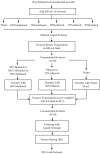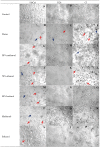Bioactive Composition, Antioxidant Activity, and Anticancer Potential of Freeze-Dried Extracts from Defatted Gac (Momordica cochinchinensis Spreng) Seeds
- PMID: 30231502
- PMCID: PMC6164636
- DOI: 10.3390/medicines5030104
Bioactive Composition, Antioxidant Activity, and Anticancer Potential of Freeze-Dried Extracts from Defatted Gac (Momordica cochinchinensis Spreng) Seeds
Abstract
Background: Gac (Momordica cochinchinensis Spreng) seeds have long been used in traditional medicine as a remedy for numerous conditions due to a range of bioactive compounds. This study investigated the solvent extraction of compounds that could be responsible for antioxidant activity and anticancer potential. Methods: Defatted Gac seed kernel powder was extracted with different solvents: 100% water, 50% methanol:water, 70% ethanol:water, water saturated butanol, 100% methanol, and 100% ethanol. Trypsin inhibitors, saponins, phenolics, and antioxidant activity using the 2,2'-azino-bis(3-ethylbenzothiazoline-6-sulfonic acid) diammonium salt (ABTS), the 2,2-diphenyl-1-picrylhydrazyl (DPPH) and the ferric reducing antioxidant power (FRAP) assays; and anticancer potential against two melanoma cancer cell lines (MM418C1 and D24) were analysed to determine the best extraction solvents. Results: Water was best for extracting trypsin inhibitors (581.4 ± 18.5 mg trypsin/mg) and reducing the viability of MM418C1 and D24 melanoma cells (75.5 ± 1.3 and 66.9 ± 2.2%, respectively); the anticancer potential against the MM418C1 cells was highly correlated with trypsin inhibitors (r = 0.92, p < 0.05), but there was no correlation between anticancer potential and antioxidant activity. The water saturated butanol had the highest saponins (71.8 ± 4.31 mg aescin equivalents/g), phenolic compounds (20.4 ± 0.86 mg gallic acid equivalents/g), and antioxidant activity, but these measures were not related to anticancer potential. Conclusions: Water yielded a Gac seed extract, rich in trypsin inhibitors, which had high anticancer potential against two melanoma cell lines.
Keywords: Gac; Momordica cochinchinensis; anticancer; antioxidant; extraction; freeze dried extract; phenolics; saponins; seeds; trypsin inhibitors.
Conflict of interest statement
The authors declare no conflict of interest.
Figures








References
-
- Wimalasiri D., Piva T., Urban S., Huynh T. Morphological and genetic diversity of Momordica cochinchinenesis (Cucurbitaceae) in Vietnam and Thailand. Genet. Resour. Crop Evol. 2016;63:19–33. doi: 10.1007/s10722-015-0232-8. - DOI
-
- Behera T., John K.J., Bharathi L., Karuppaiyan R. Momordica. In: Kole C., editor. Wild Crop Relatives: Genomic and Breeding Resources. Springer; Heidelberg, Germany: New York, NY, USA: 2011. pp. 217–246.
-
- Chuyen H.V., Nguyen M.H., Roach P.D., Golding J.B., Parks S.E. Gac fruit (Momordica cochinchinensis Spreng): A rich source of bioactive compounds and its potential health benefits. Int. J. Food Sci. Technol. 2015;50:567–577. doi: 10.1111/ijfs.12721. - DOI
-
- Huynh T., Nguyen M.H., Dao N. Biomedical importance of Momordica cochinchinensis (GAC) fruit and future applications. BJSTR. 2018;8 in press.
-
- Masayo I., Hikaru O., Tatsuo Y., Masako T., Yoshie R., Shuji H., Kunihide M., Ryuichi H. Studies on the constituents of Momordica cochinchinensis Spreng. I. Isolation and characterization of the seed saponins, Momordica saponins I and II. Chem. Pharm. Bull. 1985;33:464–478. doi: 10.1248/cpb.33.464. - DOI
LinkOut - more resources
Full Text Sources
Other Literature Sources
Miscellaneous

